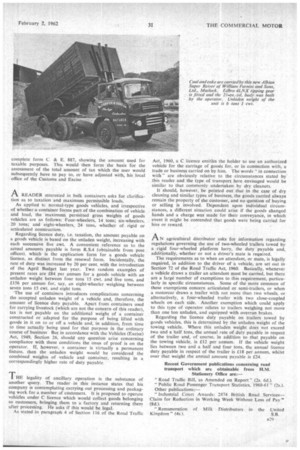A READER interested in bulk containers asks for clarification as to taxation and maximum permissible loads.
Page 87

If you've noticed an error in this article please click here to report it so we can fix it.
As applied te normal-type goods vehicles, and irrespective of whether a container forms part of the combination of vehicle and load, the maximum permitted gross weights of goods vehicles are as follows: Four-wheelers, 14 tons; six-wheelers, 20 tons; and eight-wheelers, 24 tons, whether of rigid or articulated construction.
Regarding licence duty, i.e. taxation, the amount payable on a goods vehicle is based on the unladen weight, increasing with each successive five cwt. A convenient reference as to the actual amounts payable is form R.S.4 (obtainable from post offices), which is the application form for a goods vehicle licence, as distinct from the renewal form. Incidentally, the rate of duty was increased by 20 per cent, with the introduction of the April Budget last year.. Two random examples of present rates are £84 per annum for a goods vehicle with an unladen weight between four tons 15 cwt. and five tons, and £156 per annum for. say, an eight-wheeler weighing between seven tons 15 cwt. and eight tons.
The use of containers introduces complications concerning the accepted unladen weight of a vehicle and, therefore, the amount of licence duty payable. Apart from containers used for carrying livestock (which are not the concern of this reader), tax is not payable on the additional weight of a container constructed or adapted for the purpose of being lifted with goods in it on to or off a vehicle and, in addition, from time to time actually being used for that purpose in the ordinary course of business But in accordance with the Vehicles (Excise) Act, 1949, Section 26. should any question arise concerning compliance with these conditions the onus of proof is on the operator. If, however, a container is virtually a permanent fixture. then the unladen weight would be considered the combined weights of vehicle and container, resulting in a correspondingly higher rate of duty payable.
THE legality of ancillary operation is the substance of another query. The reader in this instance states that his company is contemplating carrying out processing and packaging work for a number of customers. It is proposed to operate vehicles under C licence which would collect goods belonging to customers, bringing them to a factory and returning them after processing. He asks if this would be legal.
As stated in paragraph 4 of Section 116 of the Road Traffic Act, 1960, a C licence entitles the holder to use an authorized vehicle for the carriage of goods for, or in connection with, a trade or business carried on by him. The words "in connection with" are obviously relative to the circumstances stated by this reader and the type of transport here envisaged would be similar to that commonly undertaken by dry cleaners.
It should, however, be pointed out that in the case of dry cleaning and similar types of business, the goods carried always remain the property of the customer, and no question of buying or selling is involved. Dependent upon individual circumstances, a different situation could arise if the goods changed hands and a charge was made for their conveyance, in which event it might be contended that goods were being carried for hire or reward.
AN agricultural distributor asks for information regarding regulations governing the use of two-wheeled trailers towed by a -rigid four-wheeled platform lorry, the duty payable and, additionally, whether or not a driver's mate is required.
The requirements as to when an attendant, or mate, is legally required, in addition to the driver ofa vehicle, are set out in Section 72 of the Road Traffic Act, 1960. Basically, whenever a vehicle draws a trailer an attendant must be carried, but there are a large number of exemptions to this requirement, particularly in specific circumstances. Some of the more common of these exemptions concern articulated or semi-trailers, or when a motorcar draws a trailer with not more than two wheels, or alternatively, a four-wheeled trailer with two close-coupled wheels on each side. Another exemption which could apply to this type of operator relates to trailers weighing not more than one ton unladen, and equipped with overrun brakes.
Regarding the licence duty payable on trailers towed by goods vehicles, this is determined by the unladen weight of the towing vehicle. Where this unladen weight does not exceed two and a half tons, the annual rate of duty payable in respect of the trailer and, of course, in addition to that payable on the towing vehicle, is £12 per annum. If the vehicle weight lies between two and a half and four tons, the annual licence duty payable in respect of the trailer is £18 per annum, whilst over that weight the annual amount payable is £24.
Recent Government publications concerning road transport which are obtainable from H.M. Stationery Office are:—
" Road Traffic Bill, as Amended on Report" (2s. 6d.). "Public Road Passenger Transport Statistics, 1960-61" (2s.). Other publications:—
" Industrial Court Awards: 2874 British Road Services— Claim for Reduction in Working Week Without Loss of Pay' (8d.).
"Remuneration of Milk Distributors in the United Kingdom (4s.). S.B.




























































































































